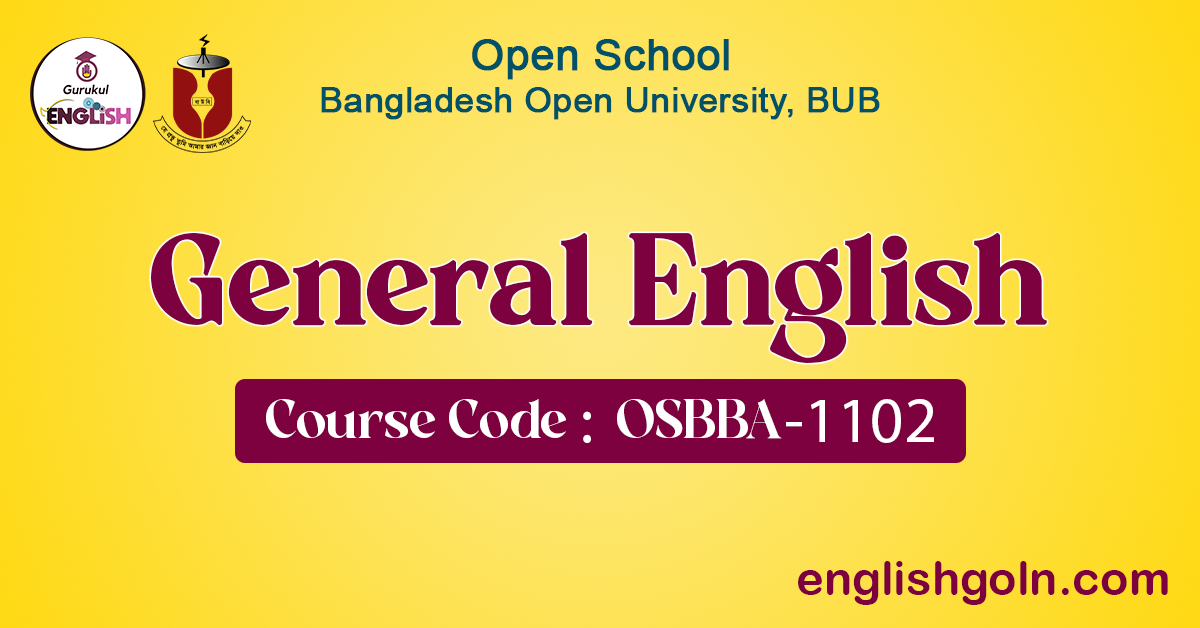BUB OSBBA 1102 General English: Welcome to the dynamic world of language mastery with “General English” (Code 1102), a pivotal component of the Bachelor of Business Administration (BBA) program at the School of Business (SOB), Open University of Bangladesh. This course is meticulously designed to empower students with the essential communication skills necessary for success in the contemporary business landscape. In an era where effective communication transcends boundaries and plays a central role in professional achievement, this book serves as a comprehensive guide, offering a structured approach to enhance language proficiency.
Focusing on practical applications, diverse exercises, and real-world scenarios, “General English” aims to equip BBA students with the linguistic tools and confidence needed to excel in their academic pursuits and future careers. Embrace the language development journey, and may this resource be your steadfast companion in honing the vital skill of effective communication.
| Course Name | Course No. |
| Index | BUB OSBBA 1102 General-English – Inner |
| Parts of Speech | BUB OSBBA 1102 General-English – Unit-01 |
| Tense | BUB OSBBA 1102 General English – Unit-02 |
| Sentences | BUB OSBBA 1102 General English – Unit-03 |
| Structure of Sentence | BUB OSBBA 1102 General English – Unit-04 |
| Use of Articles | BUB OSBBA 1102 General English – Unit-05 |
| Gerund, Infinitive, Participle, Modal Auxiliaries | BUB OSBBA 1102 General English – Unit-06 |
| Punctuation | BUB OSBBA 1102 General English – Unit-07 |
| Capitalization | BUB OSBBA 1102 General English – Unit-08 |
| Translation | BUB OSBBA 1102 General English – Unit-09 |
English, a West Germanic language in the Indo-European language family, originated in early medieval England and, today, is the most spoken language in the world and the third most spoken native language, after Mandarin Chinese and Spanish.
English is the most widely learned second language and is either the official language or one of the official languages in 59 sovereign states. There are more people who have learned English as a second language than there are native speakers. As of 2005, it was estimated that there were over two billion speakers of English.
BUB OSBBA 1102 General English
General English contents
Unit 1: PARTS OF SPEECH
- Lesson – 1.1: Parts of Speech and kinds
- Lesson – 1.2: Noun and kinds
- Lesson – 1.3: Pronoun and kinds
- Lesson – 1.4: Verb and kinds
- Lesson – 1.5: Adjective and kinds
- Lesson – 1.6: Adverb and kinds
- Lesson – 1.7: Preposition and kinds
- Lesson – 1.8: Conjunction and kinds
- Lesson – 1.9: Interjection and kinds
Unit 2: TENSE
- Lesson – 2.1: Definition of Tense and Categories
- Lesson – 2.2: Past Tense
- Lesson – 2.3: Present Tense
- Lesson – 2.4: Future Tense
Unit 3: SENTENCES
- Lesson – 3.1: Kinds of Sentences
- Lesson – 3.2: Conditional Sentences
- Lesson – 3.3: Asking Questions
Unit 4: STRUCTURE OF SENTENCE
- Lesson – 4.1: Structure of Sentences
- Lesson – 4.2: Sentence errors and faulty arrangements
- Lesson – 4.3: Common errors
Unit 5: USE OF ARTICLES
- Lesson- 5.1: Indefinite Article
- Lesson – 5.2: Definite Article
- Lesson – 5.3: No Article and Exceptions
Unit 6: GERUND, INFINITIVE, PARTICIPLE, MODAL AUXILIARIES
- Lesson – 6.1: Definition of Gerund
- Lesson – 6.2: Definition of Infinitive
- Lesson – 6.3 Definition of Participle
- Lesson – 6.4: Modal Auxiliaries
Unit 7: PUNCTUATION
- Lesson – 7.1: Definition and Kinds
- Lesson – 7.2: The Common Punctuation
- Lesson – 7.3: Terminal Punctuations
- Lesson – 7.4: Pausing Punctuations
- Lesson – 7.5: Other Punctuations
Unit 8: CAPITALIZATION
- Lesson – 8.1 Introduction and Definition
- Lesson – 8.2: Nouns or Naming Words
- Lesson – 8.3: Titles and Designations
- Lesson – 8.4: Various Genres
Lesson – 8.5: Other Rules
Unit 9: TRANSLATION
- Lesson – 9.1: Rules and Kinds
- Lesson – 9.2: Literal Translation
- Lesson – 9.4: Idiomatic Translation
- Lesson – 9.5: Passage Translation
As of my last knowledge update in January 2022, I don’t have specific information about the Bachelor of Business Administration (BBA) program at the School of Business (SOB) of the Open University of Bangladesh (OUB). However, I can provide general information about BBA programs.
A Bachelor of Business Administration (BBA) program typically offers a comprehensive education in various aspects of business and management. The curriculum may cover subjects such as marketing, finance, human resources, organizational behavior, and strategic management. BBA programs often aim to equip students with a solid foundation in business principles and prepare them for leadership roles in diverse industries. Open University programs, including those in business, often cater to non-traditional students by providing flexible learning options, including distance education.
